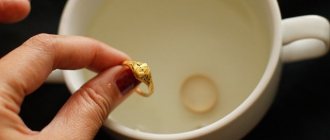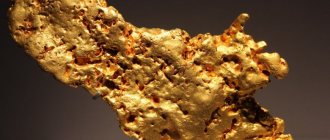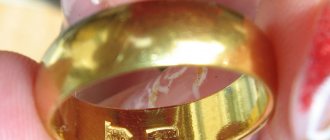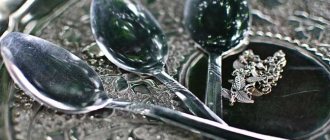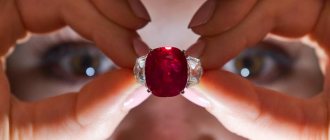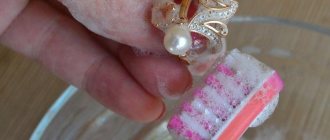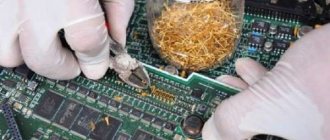Adviсe
- All that glitters is not gold
- Iodine test
- Magnet check
- Vinegar test
- By the tooth
- Determining the authenticity of gold using analytical instruments
- Determination of product weight and density
- Silver test
The fear of being deceived haunts many people, and this fear is not unfounded. According to statistics, over the past 10 years the production of precious metals has practically not increased, but at the same time the number of jewelry stores is growing at an incredible pace. Alas, even when buying jewelry in a jewelry store, there is a chance of running into a low-quality fake. Are you overcome by doubts? Verifying the authenticity of precious metals is available not only to specialists, but to each of us. There are many ways to do this, which can be done at home.
How to choose the right platinum
Platinum today is an expensive precious metal that is widely used in jewelry. It has external similarities with white gold and silver. Silver can often be passed off as platinum. Especially if you buy metal secondhand. It is advisable to make such purchases in trusted jewelry stores. But you shouldn’t let your guard down there either. It is almost impossible to visually distinguish platinum from a fake, but there are some nuances that you should definitely pay attention to.
Due to the high cost of metal, jewelry made from it is rarely massive. Most likely, these are neat, miniature products. Also pay attention to the ability to heat up. Try warming the jewelry in your palms for a few minutes. If it does not take your body temperature, then you are dealing with the original.
Be sure to look at the presence of the sample (850, 900, 950, 999) and at the data indicated on the tag or in the so-called product passport. Under no circumstances agree to purchase jewelry without these attributes.
Other verification options
Almost all noble metals are immune to the effects of magnets. This property can be used for testing. If the item you purchased is attracted to a magnet, it is most likely made of steel. There will be no platinum in such jewelry or it is contained in a minimal amount.
You can conduct another relatively simple experiment to determine the authenticity of platinum at home. It is quite interesting and will allow you to check the real nature of the material from which the jewelry is made. To carry it out you will need:
- tin can;
- concentrated solution of table salt;
- battery.
Salt water is poured into the jar and the product is lowered. Then the supposed platinum is connected to the positive pole of the battery, and the wall of the tin container is connected to the negative pole. If the item being tested is actually made of a noble metal, chlorine will begin to release from the solution. It can be identified by its characteristic pungent odor. The liquid will remain transparent. If there is counterfeit in the container, the solution will become cloudy and sediment will fall to the bottom of the jar.
The most reliable results can be obtained by an expert who can distinguish platinum from silver. It is unlikely that it will be possible to repeat the tests used by a specialist at home.
How to check the authenticity of platinum at home
Platinum has a pure white luster that is unlike any other metal. Silver of even the highest standard will have a grayish tint.
Do you think it is necessary to distinguish platinum yourself? Here are several ways to test platinum.
Ammonia or ammonia
Ammonia is easy to obtain at any pharmacy. Ammonia will not react with metal, unlike others that leave dark stains. If no reaction occurs, you are the happy owner of a real jewel.
Iodine
Contact with iodine will cause a dark spot to appear on the platinum. It can be easily removed immediately after the experiment. The darker the color of the spot, the higher the grade of the metal.
Salt
Salt will also come to the rescue if you need to check the authenticity of the jewelry. This experiment will require a little work. You will need:
- can;
- batteries;
- salt and water solution.
Pour the solution into a jar and place the decoration in it. The plus batteries must be connected to the product, and the minus batteries must be connected to the jar. If sediment forms and the liquid becomes cloudy, you are dealing with a fake. If the water remains clear, everything is fine. If you smell chlorine, don't be alarmed. This is the result of the reaction. You have the original in your hands.
Magnet
This method is the least effective, but also has a right to life. Like other noble metals, platinum is not attracted to magnets. This will protect you from crude counterfeiting, but it will not be possible to distinguish silver from platinum in this way.
Criteria for choosing platinum products when purchasing
Of course, no one will carry ammonia or, especially, a mixture of acids with them when purchasing a platinum product. How can you check that the seller is offering original jewelry? It goes without saying that the first thing you should pay attention to is the stamp on the reverse side of the product. Every self-respecting manufacturer must put it on all jewelry.
You can do a test with a magnet. All noble metals are immune to its power. However, this method does not guarantee 100% results, because silver will also not be attracted.
Platinum test
In a store, you can weigh a gold product on one palm and put platinum on the other. Whatever is heavier will be the metal you are looking for. If you still have doubts about the originality of platinum, it is better to make a purchase in the presence of a specialist or someone who is at least theoretically versed in the selection of such things.
How to distinguish platinum from other metals
From silver
The most common item given out under the guise of an expensive metal is silver. Here are a few criteria to consider when choosing platinum jewelry that will help determine the authenticity of the platinum.
- Hue. The original will always be lighter and whiter than silver. If your platinum jewelry has darkened over time, it is most likely sterling silver.
- Silver is much lighter. Their weight varies significantly. Jewelry of the same size will always weigh differently.
- Density. This indicator for white metal is one of the highest among others, so it is not susceptible to almost any mechanical influence.
- Temperature resistance. Platinum is much more resistant to high temperatures. For example, if you bring it to an open fire, nothing will happen to it. Silver heats up very quickly and takes on ambient temperature. This can be checked by even holding the product under hot water for several minutes.
How to distinguish platinum from white gold
Less often, white gold is given out under the guise of an expensive metal. An important difference, which unfortunately cannot be checked when purchasing, is that white gold is an alloy of several metals. As a rule, these are nickel, palladium, silver and yellow gold itself.
In the case of white gold, one of the elements added to it can cause allergies. Platinum, unlike white gold, does not cause allergies.
Again, don't forget to make sure you have a sample. The fineness values for platinum and white gold are different. For gold it is 500, 585, 750, and for white metal it is 850, 900, 950.
Gold is easily subject to mechanical stress. It is easy to scratch or leave marks on it. Platinum has a very high density, so this shouldn’t happen to it.
The weight, as in the case of silver, is very different. Platinum is much heavier.
White gold, although it has this name, still has different shades. This occurs due to the presence of certain elements in the alloy. Platinum jewelry always has a noble white tint. The only shade very similar to precious metal is the rhodium plating. It shines beautifully and also has a white undertone, which makes it almost impossible to visually distinguish it from its more expensive relative. However, over time, this coating begins to wear off and needs to be renewed.
The difference is also in cost. Products made from premium metal will never cost less than white gold.
From stainless steel
Stainless steel is very difficult to distinguish. In the question of how to determine platinum, methods that work for other metals will not help. Pay attention to the price. Steel will cost much less. There will be no markings on steel, while platinum jewelry will always have one.
Otherwise, it is possible to distinguish stainless steel from platinum only in the laboratory by taking physical measurements.
Experience with table salt
This method of determining platinum will appeal to those who love experiments. Conduct the experiment as follows:
- Pour concentrated brine solution into a canning jar.
- Dip the product into the liquid.
- Connect the decoration to the plus of the battery, and the jar itself to the minus.
- Study the results of the study.
If a precipitate has formed in the solution and the liquid has become cloudy, then this is 100% counterfeit. After real platinum, the solution remains clear, but as a result of the reaction, chlorine is released. You will recognize this volatile substance by its characteristic odor.
Platinum as a catalyst
This expensive metal, in addition to jewelry, has a very wide range of applications in other areas. For example, in technical applications it is used as a catalyst. It produces nitric acid. Platinum catalysts accelerate many chemical reactions, which is why it is also used in the production of sulfuric acid. In 1821, a chemist from Germany discovered the property of platinum catalysts to accelerate the process of converting wine alcohol into wine vinegar without exposure to high temperatures. At the same time, he noted that nothing happens to the metal itself. He also found out that a mixture of oxygen and hydrogen, when interacting with platinum black or platinum sponge, causes combustion. And due to the active release of heat, an explosion occurs. Thus, he invented a means of making fire before matches were invented.
The world's first platinum catalyst was produced in the 60s of the last century. It was a dehydrogenation catalyst.
Platinum is also used as a catalyst in other industries. This:
- Oil refining industry, where it is also used as a catalyst;
- Electrical engineering sector of production. It is used for the production of various sensors, electrical appliances, contacts, devices where high precision is required;
- Automotive industry. In this case, platinum is used as a catalyst;
- Space industry. Electrodes of fuel cells in spacecraft are manufactured
- Medicine. All surgical interventions are performed with platinum instruments; metal is also used in dentistry, cardiology, and for the manufacture of prosthetic parts
- Glass. Metal is used to produce high-quality optical devices. They also produce fiberglass and equipment for the production of premium quality glass.
- Chemical instruments.
How to extract platinum from a catalyst
Many resourceful people, knowing about the great value of the metal, know how to extract platinum from a catalyst and use it. Most often, platinum catalyst can be found in the automotive industry. It is from such a catalyst that the precious metal is most often extracted. An auto component filled with ceramics or metal looks like a honeycomb, and its upper part is coated with precious metal. It could be platinum, rhodium or palladium. This is necessary in order to reduce the level of toxic substances released during vehicle operation.
Resourceful people, knowing about this deposition, use auto catalysts to extract the noble metal. To extract tolls, two methods are used:
- leaching;
- "aqua regia"
The leaching method is most often used. To carry it out you will need nitric and hydrochloric acids. Due to the fact that the auto catalyst is made of ceramic or aluminum, this complicates the leaching process, since the ceramic or metal reacts with acids and oxidizes. This results in the loss of some platinum. Therefore, this method requires several catalysts.
First, the catalyst is soaked in a solution of hydrochloric acid. Then it is heated and, when vapor appears, oxidizing agents are applied.
Chemical methods
If the authenticity of a piece of jewelry is in doubt, you can check it using chemical agents . Due to their natural properties, all metals react differently.
The simplest reaction, which is easy to carry out at home, is a test with hydrogen sulfide. To do this, you will need to take a stale egg and place the product on it.
If the item is made of silver, the metal will react with hydrogen sulfide, which releases the egg and turns black. Platinum does not enter into such an interaction and its color during this experiment will remain the same.
There are other ways to determine the authenticity of platinum using chemicals:
- You can drop an alcohol tincture of iodine onto the surface of the platinum. At the same time, the liquid will retain its dark color. The more saturated it is, the higher the sample of the material under study.
- When interacting with liquid ammonia, most metals become covered with a black coating. Platinum is an exception in this sense. This feature can be used to determine the authenticity of the material.
- The method of distinguishing platinum from other metals using aqua regia is unsafe and is not advisable to use at home. However, it does exist and in some cases allows you to determine whether the purchased jewelry is actually made of platinum. The term “regia vodka” means a mixture of 3 parts concentrated nitric acid and 1 part sulfuric acid. Almost all metals dissolve in this composition, but it does not affect platinum. Please note that the solution must be taken cold. If you heat a mixture of acids, it can even dissolve platinum.
History of the use of platinum and silver
Silver has been known since ancient times, and it is impossible to name the date when people learned to mine and use it, even within a century. Since silver occurs in native form (that is, it does not need to be smelted from ore), mining was limited to finding nuggets and their subsequent processing. In Ancient Assyria and Babylonia, silver was considered a magical symbol of the Moon back in the second millennium BC and was used for making religious objects, as well as for minting coins. A little later, silver became popular in Ancient Hellas: for example, tetradrachms (coins with a face value of four drachmas) were minted from this metal. It is even believed that it was the tetradrachms (pieces of silver) that became the coins with which Judas Iscariot received payment for the betrayal of Jesus.
In the Middle Ages, silver, in addition to being used as a metal for minting coins, became widespread in the production of church utensils, as well as tableware. Of course, silverware was expensive, and only very wealthy people could afford it. Silver was also used by alchemists, who valued not the cost of this metal, but its “magical” properties. They gleaned their “knowledge” regarding such properties from ancient treatises dating back to Assyrian and Babylonian texts.
